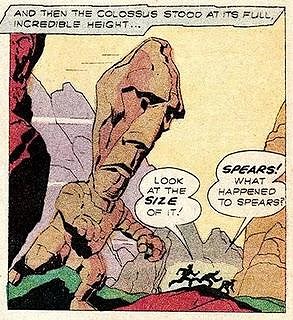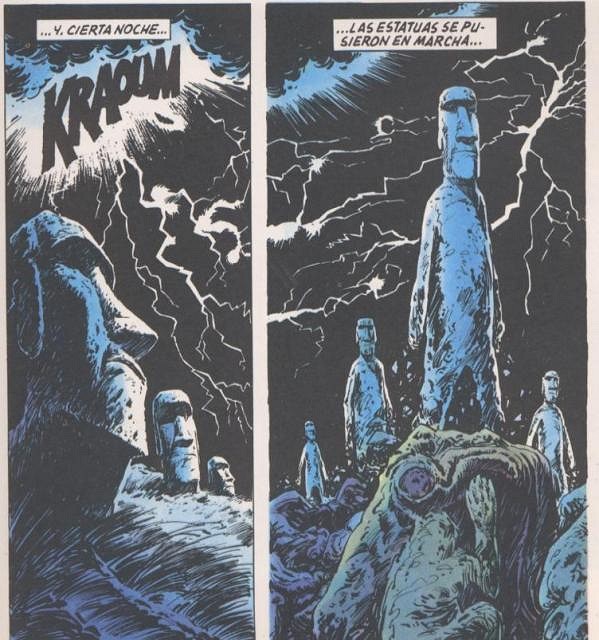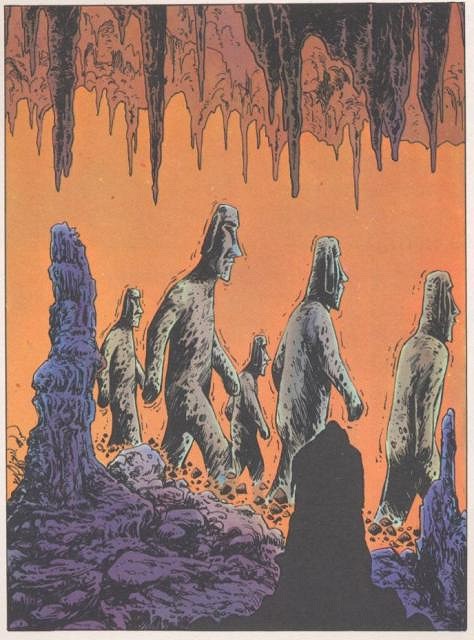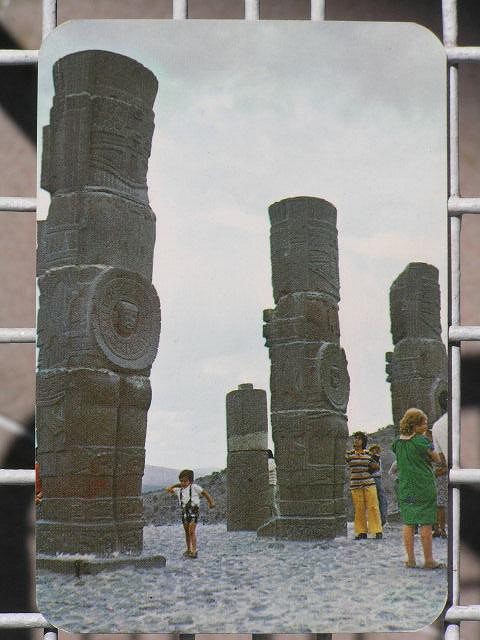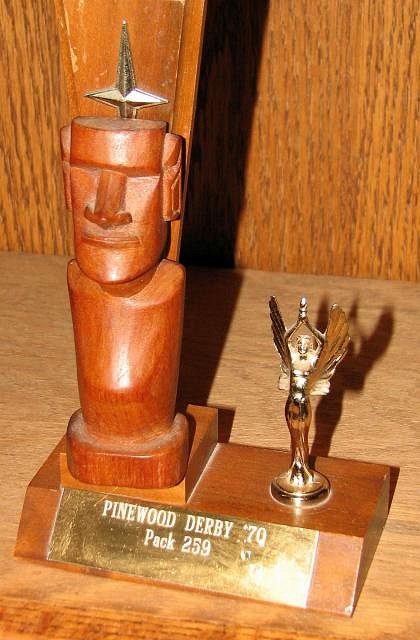Pages: 1 25 replies
|
LLT
little lost tiki
Posted
posted
on
Tue, May 25, 2010 12:52 PM
Interesting Article! Scientists reveal the secrets of Easter Island's fallen idols By Cahal Milmo According to Polynesian legend, the stone monoliths of Easter Island were put into place by a king who invoked divine power to command the statues to walk. Archaeologists have long preferred the more prosaic theory that they were heaved into position along a network of purpose-built tracks. But the first British archaeological expedition in nearly a century to the archipelago, whose giant artifacts have long baffled academics and explorers, has arrived at a conclusion which threatens to overturn a 50-year-old consensus about the role played by the island's ancient road system. The team, from London and Manchester, travelled to the island off Chile to examine the toppled minimalist statues which researchers have long believed were abandoned on the roadside during failed attempts to haul them from inland quarries to their final vantage points overlooking the coast. There are about 1,000 statues, most on platforms on the island's perimeter, with others inland in an apparently random fashion. The theory about these inland rock effigies, which are known as moai and weigh up to 86 tons each, was first outlined in 1958 by the Norwegian adventurer Thor Heyerdhal, who suggested that the ancient Polynesians simply left the broken statues beside the track and they served no spiritual purpose. But evidence from the researchers, from University College London (UCL) and Manchester University, has upset this convention after hi-tech equipment discovered that, far from being the detritus of clumsy construction workers, each of the tumbled statues had a stone platform and would have had pride of place on the road system as part of a religious avenue. The discovery confirms the findings of the last British archaeologist to work on the island, Katherine Routledge, in 1914, and suggests that rather than serving solely as a transportation route for coast-bound statues, the system of tracks criss-crossing the archipelago had a more complex role. Researchers have long assumed that the quarry in an extinct volcano, Rano Raraku, where the statues were carved, was merely a workplace from which the roads fanned out to the coastal sites. The latest findings show that the volcano was in fact also a sacred site. Dr Sue Hamilton, of UCL, said: "Ever since Heyerdhal, it has been assumed that the roads were used for transportation and little else. But what we know now is that the roads very much had a ceremonial function and the quarry was where the islanders would go because it was a sacred centre. "The statues by the roadside were not abandoned. They had individual platforms and faced in towards the road. They ended up on the ground after falling over in the intervening centuries but we think it is beyond doubt that they intended to stand where they were found. Volcano cones were considered as points of entry to the underworld by the ancient inhabitants of the island. It seems that the volcano was a holy place. It was the birthplace of the statues and people would come to it rather like a cathedral." The British team say that as the roads approach Rano Raraku, the statues become more frequent, suggesting they form the climax of a processional route to the volcano. The inhabitants of Easter Island, carved their figures between 1200 and 1500AD. The tallest statue, named Paro, is almost 10m high and weighs 75 tonnes. Several expeditions have tried to re-create their transport, using wooden rollers and timber A-frames. But Dr Hamilton said: "If you just focus on one part of the story of Rapa Nui [the tribal name for Easter Island], then you will miss the wider history. We will not get the answers to how the statues were moved; we need to consider them in the context of their landscape and its spiritual dimension." |
|
T
TikiG
Posted
posted
on
Tue, May 25, 2010 1:11 PM
Yeah Kinney - very interesting. I've always wondered about the bigger picture, the statues "in the context of their landscape and its spiritual dimension." Best of all, and I say must respond with Thanks for posting this, is the inspiration this article has given me to paint a nice large canvas (diorama) of the Rano Raraku volcano as a cathedral with the statues, ceremonial roads, native peoples in procession towards the volcano etc. Real moody and atmospheric like. I'll be at my easel tonight I think. Cheers! G |
|
LLT
little lost tiki
Posted
posted
on
Tue, May 25, 2010 1:40 PM
Go G Go! |
|
H
HelloTiki
Posted
posted
on
Tue, May 25, 2010 2:08 PM
They walked? Someone paint o picture of this please. |
|
LLT
little lost tiki
Posted
posted
on
Tue, May 25, 2010 2:25 PM
YOU NEED TO READ THE WHOLE ARTICLE |
|
J
JOHN-O
Posted
posted
on
Tue, May 25, 2010 2:47 PM
All that science stuff is a bunch of baloney. You know how those idols got there? They walked !! The ancient Polynesians had it right. :D |
|
LLT
little lost tiki
Posted
posted
on
Tue, May 25, 2010 3:54 PM
SO THAT JACK KIRBY COMIC WAS TRUE! One question tho...... |
|
M
MadDogMike
Posted
posted
on
Tue, May 25, 2010 4:29 PM
Where did I see that diagram? One theory was that they put a yoke around the Moai's neck with 2 legs on it, forming a tripod with the Moai. Using gravity, the Moai "walked" downhill - first the Moai swung through the 2 legs then the legs swung past the Moai. |
|
J
JOHN-O
Posted
posted
on
Tue, May 25, 2010 6:00 PM
Dig, LLT, Dig !! |
|
UB
Unga Bunga
Posted
posted
on
Wed, May 26, 2010 12:27 AM
After four shots of Okolehao, every thing starts walkin'. |
|
M
MadDogMike
Posted
posted
on
Wed, May 26, 2010 11:59 AM
Here you go, make your own walking Moai |
|
LLT
little lost tiki
Posted
posted
on
Wed, May 26, 2010 12:02 PM
I HEARD THAT METHOD WORKS GREAT FOR SMALL SOUVINEER OR PAPER MOAIS! |
|
C
christiki295
Posted
posted
on
Wed, May 26, 2010 10:48 PM
Fascinating! |
|
MN
Mister Naufrago
Posted
posted
on
Thu, May 27, 2010 6:29 PM
...and one night...
|
|
4
4WDtiki
Posted
posted
on
Thu, May 27, 2010 7:27 PM
Hmm, I envision a Tiki Central version of the Pinewood Derby! |
|
P
Paipo
Posted
posted
on
Thu, May 27, 2010 7:40 PM
Who did this cool artwork? Looks like Bissette/Totleben Swamp Thing...that birdman petroglyph is smokin! |
|
M
MadDogMike
Posted
posted
on
Thu, May 27, 2010 7:47 PM
Good idea Bill :D |
|
MN
Mister Naufrago
Posted
posted
on
Thu, May 27, 2010 10:21 PM
Belgian comic book artist William van Cutsen aka Willian Vance.
|
|
LLT
little lost tiki
Posted
posted
on
Fri, May 28, 2010 8:03 AM
Awesome! Awesome! and Billy... |
|
LL

Limbo Lizard
Posted
posted
on
Fri, May 28, 2010 10:28 AM
Soap Box Derby - wooden cars big enough for a child "driver". |
|
Z
Zeta
Posted
posted
on
Sat, May 29, 2010 12:26 AM
Nice "Bande desinee" Mr. Naufrago! Please show us some more! To me, all this sounds like the super string theory applied. I love this. The Idea of an Atlantis/electro/lemuria/transformer/tron/tiki idea. Volcanic rock coming to life by the intent of a brujo. Cool stuff. Example:
What about the "aliens did it" theory? Is there a thread where this is seriously discussed? where is martian-tiki? One day in Madrid I went into a used book store and saw a book that had drawings of the appearance of the Easter island aliens... breathtaking... I didn't bought the book ( I already had bought a plastic groceries store size full of old paper) I regret it so much! that graphic of that moai-tiki-alien was priceless... sigh... what was I thinking?!? P.P. Super energy belts now available! |
|
K
kingstiedye
Posted
posted
on
Sat, May 29, 2010 12:57 AM
i kicked ass in moai pinewood derby back in the day! |
|
LLT
little lost tiki
Posted
posted
on
Mon, May 31, 2010 9:25 AM
Zaya-great theory! Congrats Bullet! :lol: Tikis right arm. |
|
C
Chippieleigh
Posted
posted
on
Sun, Jun 6, 2010 7:40 PM
how about a palm log derby ? http://www.youtube.com/watch?v=Z2395gyWjw8&feature=player_embedded |
|
T

tikibars
Posted
posted
on
Sun, Jun 6, 2010 10:04 PM
I wonder why the author of this article keeps referring to Easter Island as an archipelago? and... Yes, in my book big Stone Head. |
|
M
MadDogMike
Posted
posted
on
Mon, Jun 7, 2010 12:02 PM
Chippie, I like that video - can we wear the traditional outfits for the derby? Tikibars, seems I remember at least one other island off the coast that the birdbird cult would swim to through shark infested waters each year to collect bird eggs. I'm sure there are other small islands off the coast too. An archipelago is not always what we would picture - Scotland is considered an archipeligo because it is surrounded by more than 700 little islands. |
Pages: 1 25 replies

